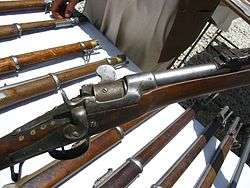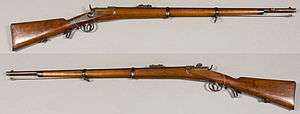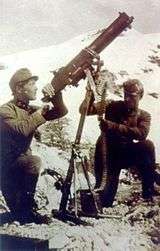Werndl–Holub rifle
The M1867 Werndl–Holub was a single-shot breechloading rifle that the Austro-Hungarian army adopted in 1867. It replaced the Wanzl breechloader conversion of the muzzle-loading Lorenz rifle. Josef Werndl (1831–1889) and Karel Holub (1830–1903) designed and patented their rifle; Werndl later bought out all the rights, but was involved in name only.


ŒWG (Österreichische Waffenfabriksgesellschaft) produced the Werndl and chambered it for the 11mm scharfe Patrone M.67[15] (11.15×42mmR) cartridge. In 1877, the military rechambered the Werndl for the bottleneck 11mm scharfe Patrone M.77 (11.15×58mmR) cartridge.
In spite of the Werndl being long obsolete by World War I, the Austro-Hungarian forces issued Werndl rifles to rear-echelon units to free up more modern rifles for use by front-line troops.[15]
Comparison with contemporary rifles
| Calibre | System | Country | Velocity | Height of trajectory | Ammunition | ||||||||
|---|---|---|---|---|---|---|---|---|---|---|---|---|---|
| Muzzle | 500 yd (460 m) | 1,000 yd (910 m) | 1,500 yd (1,400 m) | 2,000 yd (1,800 m) | 500 yd (460 m) | 1,000 yd (910 m) | 1,500 yd (1,400 m) | 2,000 yd (1,800 m) | Propellant | Bullet | |||
| .433 in (11.0 mm) | Werndl–Holub rifle | Austria-Hungary | 1,439 ft/s (439 m/s) | 854 ft/s (260 m/s) | 620 ft/s (190 m/s) | 449 ft/s (137 m/s) | 328 ft/s (100 m/s) | 8.252 ft (2.515 m) | 49.41 ft (15.06 m) | 162.6 ft (49.6 m) | 426.0 ft (129.8 m) | 77 gr (5.0 g) | 370 gr (24 g) |
| .45 in (11.43 mm) | Martini–Henry | United Kingdom | 1,315 ft/s (401 m/s) | 869 ft/s (265 m/s) | 664 ft/s (202 m/s) | 508 ft/s (155 m/s) | 389 ft/s (119 m/s) | 9.594 ft (2.924 m) | 47.90 ft (14.60 m) | 147.1 ft (44.8 m) | 357.85 ft (109.07 m) | 85 gr (5.5 g) | 480 gr (31 g) |
| .433 in (11.0 mm) | Fusil Gras mle 1874 | France | 1,489 ft/s (454 m/s) | 878 ft/s (268 m/s) | 643 ft/s (196 m/s) | 471 ft/s (144 m/s) | 348 ft/s (106 m/s) | 7.769 ft (2.368 m) | 46.6 ft (14.2 m) | 151.8 ft (46.3 m) | 389.9 ft (118.8 m) | 80 gr (5.2 g) | 386 gr (25.0 g) |
| .433 in (11.0 mm) | Mauser Model 1871 | Germany | 1,430 ft/s (440 m/s) | 859 ft/s (262 m/s) | 629 ft/s (192 m/s) | 459 ft/s (140 m/s) | 388 ft/s (118 m/s) | 8.249 ft (2.514 m) | 48.68 ft (14.84 m) | 159.2 ft (48.5 m) | 411.1 ft (125.3 m) | 75 gr (4.9 g) | 380 gr (25 g) |
| .408 in (10.4 mm) | M1870 Italian Vetterli | Italy | 1,430 ft/s (440 m/s) | 835 ft/s (255 m/s) | 595 ft/s (181 m/s) | 422 ft/s (129 m/s) | 304 ft/s (93 m/s) | 8.527 ft (2.599 m) | 52.17 ft (15.90 m) | 176.3 ft (53.7 m) | 469.9 ft (143.2 m) | 62 gr (4.0 g) | 310 gr (20 g) |
| .397 in (10.08 mm) | Jarmann M1884 | Norway and Sweden | 1,536 ft/s (468 m/s) | 908 ft/s (277 m/s) | 675 ft/s (206 m/s) | 504 ft/s (154 m/s) | 377 ft/s (115 m/s) | 7.235 ft (2.205 m) | 42.97 ft (13.10 m) | 137.6 ft (41.9 m) | 348.5 ft (106.2 m) | 77 gr (5.0 g) | 337 gr (21.8 g) |
| .42 in (10.67 mm) | Berdan rifle | Russia | 1,444 ft/s (440 m/s) | 873 ft/s (266 m/s) | 645 ft/s (197 m/s) | 476 ft/s (145 m/s) | 353 ft/s (108 m/s) | 7.995 ft (2.437 m) | 47.01 ft (14.33 m) | 151.7 ft (46.2 m) | 388.7 ft (118.5 m) | 77 gr (5.0 g) | 370 gr (24 g) |
| .45 in (11.43 mm) | Springfield model 1884 | United States | 1,301 ft/s (397 m/s) | 875 ft/s (267 m/s) | 676 ft/s (206 m/s) | 523 ft/s (159 m/s) | 404 ft/s (123 m/s) | 8.574 ft (2.613 m) | 46.88 ft (14.29 m) | 142.3 ft (43.4 m) | 343.0 ft (104.5 m) | 70 gr (4.5 g) | 500 gr (32 g) |
| .40 in (10.16 mm) | Enfield-Martini | United Kingdom | 1,570 ft/s (480 m/s) | 947 ft/s (289 m/s) | 719 ft/s (219 m/s) | 553 ft/s (169 m/s) | 424 ft/s (129 m/s) | 6.704 ft (2.043 m) | 39.00 ft (11.89 m) | 122.0 ft (37.2 m) | 298.47 ft (90.97 m) | 85 gr (5.5 g) | 384 gr (24.9 g) |
See also
| Wikimedia Commons has media related to Werndl rifle. |
- Weaponry of the Austro-Hungarian Empire
- Mannlicher M1886 – the next Austro-Hungarian service rifle
References
- ↑ "The military rifle cartridges of Afghanistan part 1: from Alexander to Enfields. - Free Online Library". Thefreelibrary.com. Retrieved 5 August 2018.
- ↑ https://books.google.cz/books?id=i2IpDAAAQBAJ&pg=PA44&lpg=PA44&dq=werndl+Albania&source=bl&ots=7f3v-5toLX&sig=JIHNfO6K1PjrvGlYQbUSTCMCQT4&hl=cs&sa=X&ved=2ahUKEwj66NHWreLcAhXHN8AKHTZWDsMQ6AEwDnoECAcQAQ#v=onepage&q=werndl&f=false
- ↑ ".: Full Aventura :. - Armas - Armas de nuestra historia - 1º parte". Fullaventura.com. Retrieved 5 August 2018.
- ↑ http://www.legionitaliana.com.ar/FuerzasSitioBuenosAires1880.PDF
- ↑ "Ethiopian military rifle cartridges part 1: from the Queen of Sheba to Adowa. - Free Online Library". Thefreelibrary.com. Retrieved 5 August 2018.
- ↑ electricpulp.com. "FIREARMS i. HISTORY – Encyclopaedia Iranica". Iranicaonline.org. Retrieved 5 August 2018.
- ↑ "RIA: Gewehr 29/40 Mauser". Forgottenweapons.com. 8 February 2016. Retrieved 5 August 2018.
- ↑ "OKOP - Sklep z Militariami Kolekcjonerska Broń Deko". Okop.com.pl. Retrieved 5 August 2018.
- ↑
- ↑ https://ospreypublishing.com/blog/osprey_remembers_4
- ↑ "ČASOPIS ZA ZGODOVINO IN NARODOPISJE : Review for History and Ethnography" (PDF). Sistory.si. Retrieved 5 August 2018.
- ↑ Teinović, Bratislav. "Srpski ustanak u Bosni 1875-1878., Banjaluka 2006". Academia.edu. Retrieved 5 August 2018.
- ↑ Farmanfarmaian, Roxane (30 January 2008). "War and Peace in Qajar Persia: Implications Past and Present". Routledge. p. 63. Retrieved 5 August 2018 – via Google Books.
- ↑ https://www.forgottenweapons.com/1867-werndl-video/
- 1 2 3 Scarlata, Paul (1 August 2011). "Austro-Hungarian Rifles of World War 1 – Part One: Many Peoples – Many Rifles!". Shotgun News. 65 (21): 48.
- ↑ https://snn.sk/sokolstvo-v-bojoch-o-slovensko/
- ↑ https://dobroni.pl/n/karabin-i-karabinek/12612
- ↑ "The New Martini-Enfield Rifle" (PDF). The Engineer. 2 July 1886. p. 16. Retrieved 3 April 2017 – via Grace's Guide to British Industrial History.

